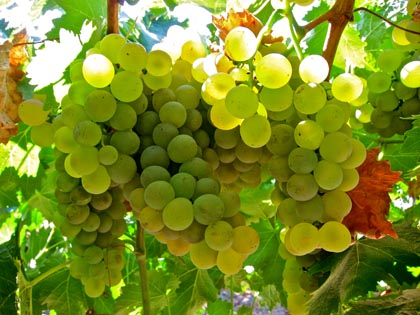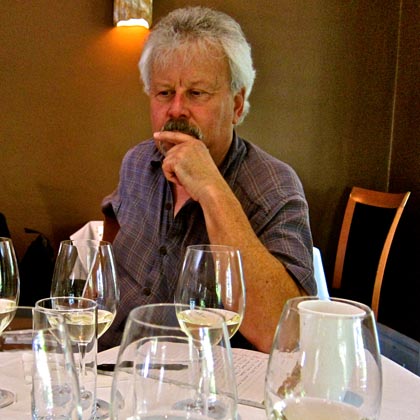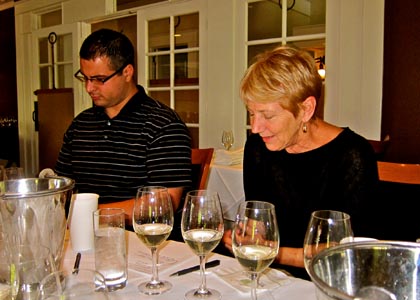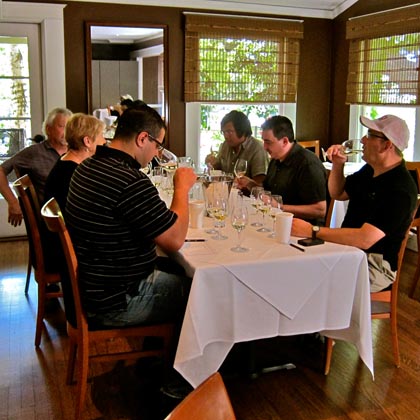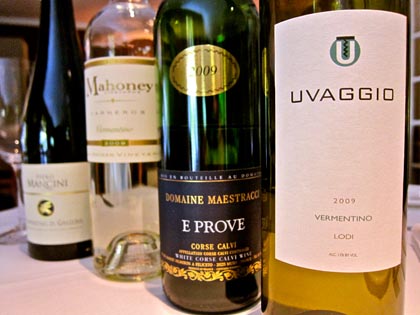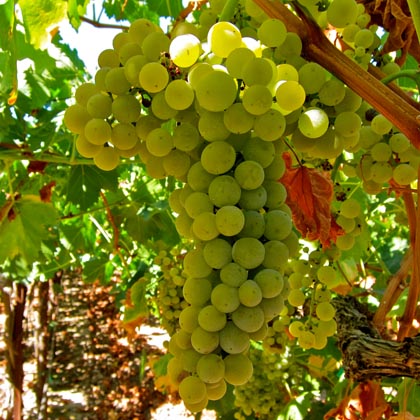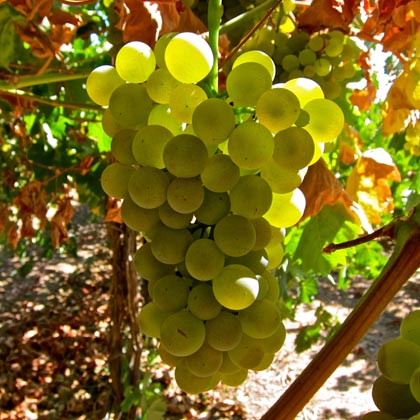Letters from Lodi
An insightful and objective look at viticulture and winemaking from the Lodi
Appellation and the growers and vintners behind these crafts. Told from the
perspective of multi-award winning wine journalist, Randy Caparoso.
Lodi’s ingenioso Vermentino & Moscato
Vermentino: the object of Jim Moore’s ardor (Bella Vigna Vineyard, Alta Mesa AVA, Sept. 2011)
Uvaggio’s Jim Moore is bullish on Lodi’s two most exotic varietal whites…
Uvaggio's Jim Moore
There has always been something of a Don Quixote in Jim Moore, winemaker/proprietor of Uvaggio, the winery formerly known by its full name, L’Uvaggio di Giacomo (“Jim’s grapes”). How else can you explain his impassioned, solitary crusade to turn the country on to Vermentino, an obscure (at least in the U.S.) grape grown in Northern Italy, the islands of Sardinia and Corsica, and France’s Provence (where the grape is known as Rolle)?
In Jim Moore’s world, every self-respecting American white wine lover should be drinking Vermentino, which he calls the “thinking man’s Pinot Grigio.” Ironically, in Moore’s previous life – 19 years spent at Robert Mondavi Winery – one of his goals was to convert Americans to California grown Pinot Grigio, which he put out as chief winemaker of the now-defunct “Cal-Ital” label, La Famiglia di Robert Mondavi.
As in many of the passages found in the book about el ingenioso hidalgo de la Mancha, when it comes to the subject of Vermentino Moore can wax on and wax off for hours, both lucidly and dreamily, on the many charms of the grape. Says Moore, “this medium bodied white possesses intriguing qualities, and a lineage dating back more than 500 years in the coastal areas of the Tyrrhenian Sea.”
You may ask why the waters off the eastern coast of Italy should concern drinkers of California (and specifically, Lodi) wine, but Moore does have a very good, if subtle, point: Vermentino, a.k.a. Rolle, may be obscure in the U.S., but in Northern Italy and Southern France it is as familiar to wine consumers as Pinot Grigio or Fumé Blanc is to us. For instance, to Lodi’s Wine & Roses Hotel Executive Chef, Didier Gerbi – who sat with us in our blind tasting comparing the Uvaggio Vermentino with other white wines made from the same grape – Vermentino is a very familiar taste. Chef Didier is, after all, French; having lived and worked for many years in that part of the world, where Vermentino is practically an everyday drinking wine.
Blind tasting: Lodi Wine & Visitors Center's Jeremy Bowe & Wine & Roses' Kathy Munson
The entire premise of Uvaggio, in fact, is based upon the following, extremely worthy goals: to produce wines having
- An overarching sense of place
- Consistency of supply
- An easy food affinity
- Compelling value (for Uvaggio, retail prices between $12 and $20)
This is also why Moore is extremely bullish on Lodi grown wine grapes: it delivers all of the above, in spades! If anyone should know, Jim Moore should. Although he still lives and works in Napa Valley, he believes it is not possible to produce such wines in Napa Valley. Therefore, every drop of Uvaggio is grown in the good ol’ Lodi AVA.
To demonstrate his point, at the end of this past August Moore sat down with a small group of us –along with Chef Didier, including Wine & Roses Hotel proprietor Kathy Munson, the “Lodi Wineguy” Jon Bjork, and Lodi Wine & Visitor Center retail manager Jeremy Bowe – to give us a taste of four white wines made from Vermentino, and four white wines made from another Uvaggio specialty grape, called Moscato Giallo.Moscato Giallo, Moore explains, is a golden skinned sub-variant of Muscat Blanc – related to, but not exactly the same, as the grapes usually used to produce fruity white wines called Moscato – and is grown in Austria, Germany, Slovenia and Italy’s Südtirol. However, this grape is so obscure, even in Europe, that our own governing agency (the ATF) does not even recognize it as a varietal (which is why Moore may not label is Moscato Giallo as “Moscato Giallo” – to the feds, Moscato Giallo does not exist). Moore produces two versions of this grape: a dry white wine (which he calls Secco), and a sweet, dessert style (labeled Dolce).
Our notes from this fascinating blind tasting:
2009 Uvaggio, Lodi Vermentino ($14)
Tasted with:
- 2009 Domaine Maestracci, Calvi Blanc (Corsica, France; $18)
- 2009 Piero Mancini, Vermentino di Gallura (Sardinia, Italy; $16)
- 2009 Mahoney, Carneros Vermentino (California; $16)
In this comparison, the Uvaggio Vermentino demonstrated the grape’s varietal character in spot-on fashion: strong stony qualities mixed with lemon/citrus as well as herby, lavender-like notes in the nose; packaged in a refreshingly crisp, buoyant, light-medium body (11.1% alcohol, to be exact), the stony, lemony, lavendery flavors finishing with a gentle, silken flourish.
If anything, what the Uvaggio lacked was the strong sense of earth-related terroir qualities found in both the Domaine Maestracci (showing an even stronger, wet stoniness mixed with gunflint, and a pungent potpourri of dried sage, lavender and fennel seeds) and the Piero Mancini (a mix of dried kitchen herbs, briny sea salt and raw honey). But this was as expected, since the Uvaggio is grown in rich, loamy Delta soils, where most wines tend to show fruit focused qualities; whereas the two European whites are grown on islands in the middle of the Mediterranean, where the soils are sparser and the air is scented with sea salt and the pervasive smell of wild, natural, woody schrub (in Corsica, called maquis).
Less dramatic was the comparison of the Uvaggio with the Mahoney Vermentino; the latter grown in Carneros, skirting the south end of Napa County along San Pablo Bay. While the soil in Carneros is pretty much a solid, shallow clay, the varietal fruit qualities of the grape also came across bright and clear in the Mahoney: sharp lemon mixed with lavender, with stony undertones.
For the Frenchman, Chef Didier, the Mancini from Sardinia tasted like a “perfect Vermentino” – slender, citrusy, almost minimalist in structure and purity of varietal fruit qualities – although he also singled out the Uvaggio as a “classic,” citing its artful blend of tart acidity and “a little fat, which I like.” Jon Bjork described all four whites as “aromatically similar… I could pick out very few differences,” while remarking on the “nice creaminess” of the Mancini from Sardinia as well as the stronger “emphasis on acidity” in (surprisingly!) the two California bottlings. Mr. Moore himself made note of the Mancini’s “musky spice” and “viscosity,” the “nutty, eccentric” qualities of the Maestracci from Corsica, and the “floral, green olive” notes of his own Uvaggio Vermentino.
Bottom line: both California wines demonstrate just as much or more varietal characteristics as the two European wines, giving credence to the argument that there is a nice, comfortable home for a grape like Vermentino here in the New World, whether or not the rest of America is aware of that.
Moscato Giallo (Bella Vigna Vineyard, Alta Mesa AVA)
2009 Uvaggio, Lodi Moscato Secco ($16)
Tasted with:
- 2009 Alois Lageder, Moscato Giallo (Alto Adige, Italy; $23)
- 2009 Heidi Schröck, Gelber Muskateller (Burgenland, Austria; $27)
- 2009 Ca’ del Solo, Monterey Muscat (California; $16)
In this comparison, the Uvaggio Moscato reaped high praise for its intensity of “minerals, musk, citrus, lemon and gooseberry” (Bjork); as well as for being “extremely delicate… with white flowers, minerality… very easy to drink all by itself” (Chef Didier). It is, in fact, a bone dry style of Moscato; significantly light on its feet (less than 12% alcohol), having more of a sharply defined, lemony crispness than the overtly fruity grapiness one usually expects wines bottled as “Moscato.”
Otherwise, the Ca’ del Solo also received kudos – particularly for its “very attractive combination of aromatics and fruit” (Bowe) and “flowery, rose petal” qualities (Chef Didier) – although the one thing that made the Ca’ del Solo different from the other Moscato Giallos was its discreet yet perceptible edge of sweetness, underlining a gay, lilting, flowery fruitiness. On the decidedly dryer, fuller bodied, fleshier side, the Schröck Muskateller from Austria was also the spiciest wine in the group – its musky fragrance mingling with cracked pepper as well as a fennel/anise, almost sausage-like pungency – whereas the equally weighty Lageder from Italy exuded floral as well as thyme-like, dried kitchen-herby spices.
Kathy Munson found the Uvaggio to be the “strongest, steeliest” wine of the bunch, while actually preferring the fuller bodied Schröck because “I think it would be easier to pair with food.” Mr. Moore’s take? He found his own Uvaggio Moscato to be almost “pepperminty” in its spiciness, pointing out its relatively lean, lighter bodied qualities in comparison with the other whites. Is this good? Put it another way: Angelina Jolie is also relatively lean and light, but packs as much punch as anyone, especially in terms of what counts most: presence. We’ll take an Uvaggio anyday!
If there were any lessons to be drawn from this particular blind tasting, it might be that
1. California grown versions of certain varieties are not necessarily fuller, fatter, or heavier than their European counterparts (considering the fact that in both the Vermentino and Moscato Giallo comparisons, the California wines turned out to be the lighter, crisper, more delicately “fine” wines).
2. Right now there is a tendency for California grown wines to be more purely varietal fruit focused, and European wines to be tinged by earthier and/or spicier notes, most likely for any number of reasons (soil, climate, vine age, experience of growers and winemakers, etc.).
3. Lodi can grow crisply balanced, light, sleek, subtle, even lean styles of wine that many wine lovers (and geeks) are looking for today.
4. Be as it may, quality judgements at this level are based more upon personal preference, as opposed to anything that can possibly be construed as “objective” – and don’t let anyone ever convince you otherwise (we don’t use the expression “so-called” wine experts for nothing).
After all, as one wine sage once put it, “we can all have great taste, but not necessarily the same taste.”
The beautifully transparent Vermentino grape
